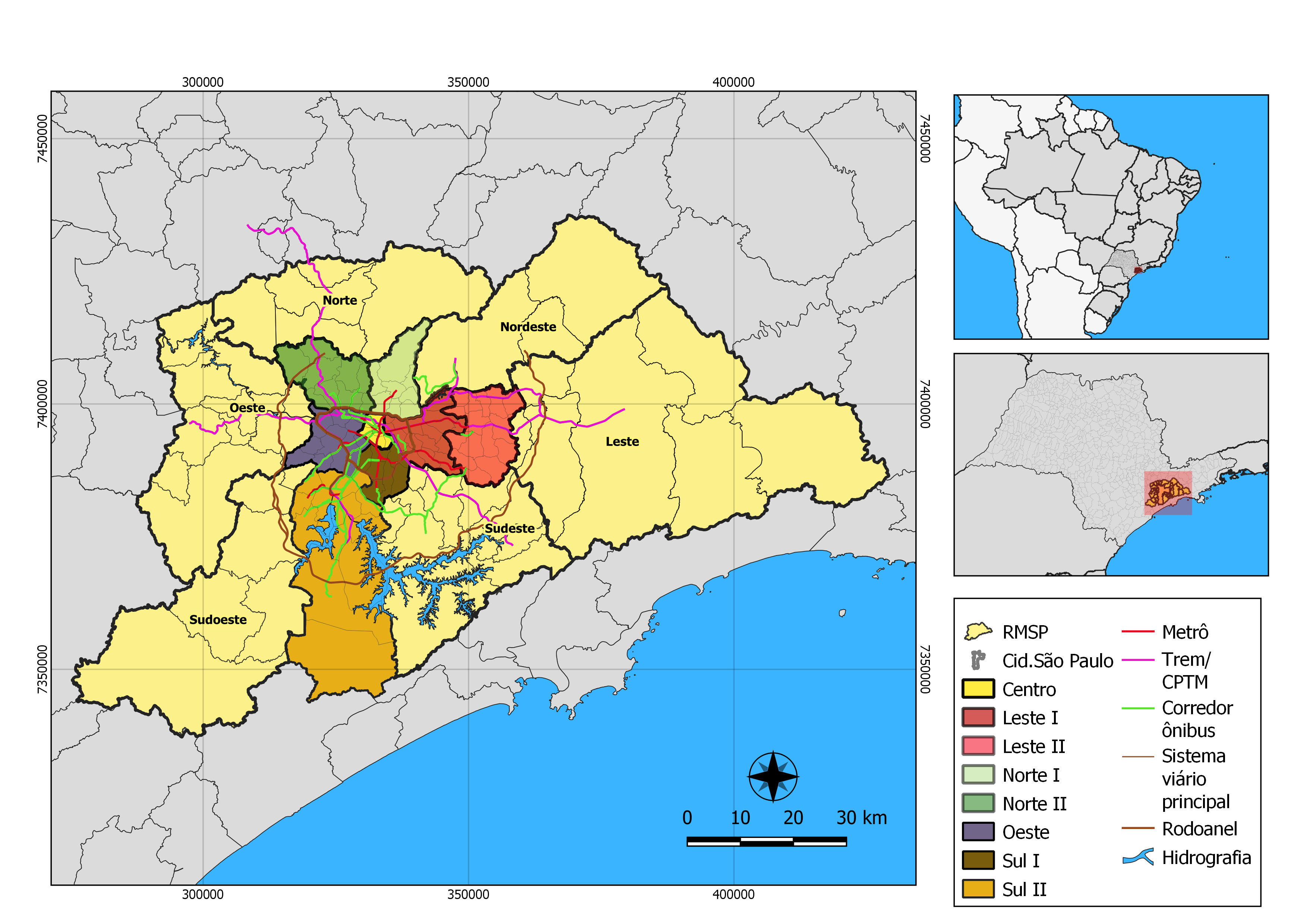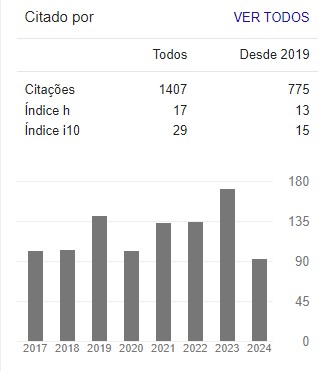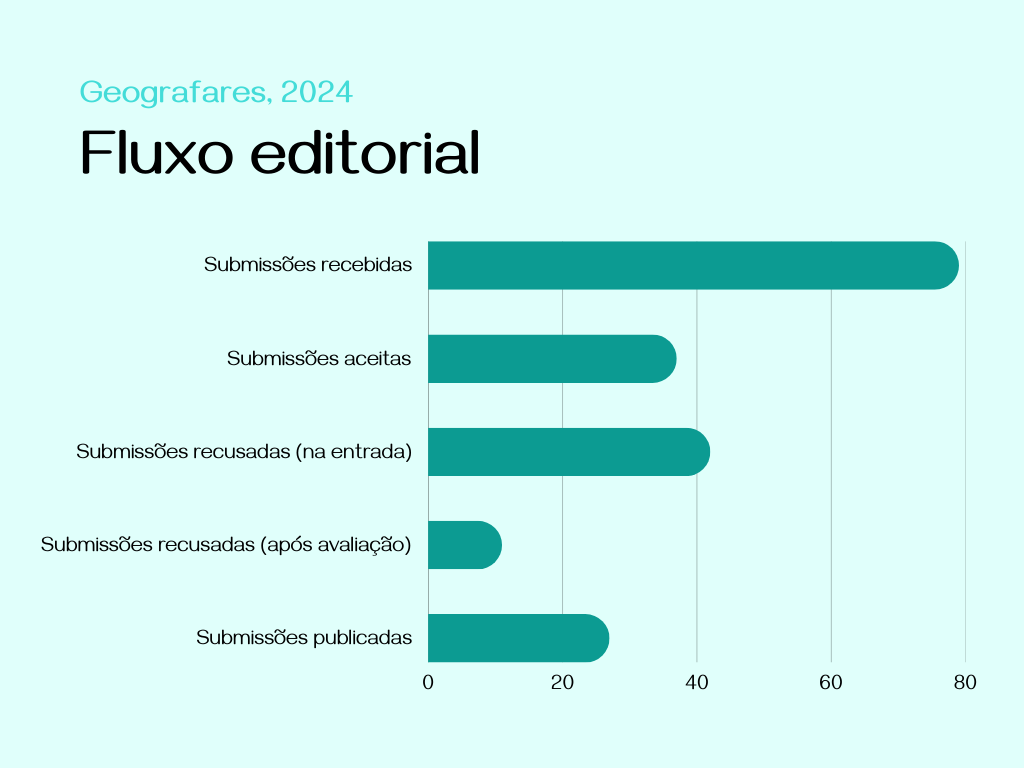Commuting time as a barrier to urban accessibility in the São Paulo Metropolitan Region (SPMR), Brazil
DOI:
https://doi.org/10.47456/geo.v4i38.43310Keywords:
urban accessibility, commuting time, barriersAbstract
This paper aims to analyze the role of commuting time in public transport for urban accessibility to employment rates in the São Paulo Metropolitan Region (SPMR), over the last three decades. The methodology used combines quantitative and qualitative approaches. The quantitative approach was based on the use of microdata from the São Paulo Metro Origin and Destination (OD) survey, for the years 1997, 2007 and 2017, to analyze the cumulative accessibility to jobs, as a function of travel time by collective mode in the MRSP. For the qualitative approach, collaborative mapping workshops on accessibility were held with University in Unified Educational Centers (UniCEU)/Open University System of Brazil (UAB) participants from Perus, Capão Redondo and Água Azul – Cidade Tiradentes centers. Commuting time was found to be a barrier to urban accessibility to jobs, especially for poor residents of the urban peripheries in the SPMR.
Downloads
References
BITTENCOURT, T.; GIANNOTTI, M. The Unequal Impacts of Time, Cost and Transfer Accessibility on Cities, Classes and Races. Cities, v. 116, p. 1-23, 2021. https://doi.org/10.1016/j.cities.2021.103257.
BOISJOLY, G.; MORENO-MONROY, A. I.; EL-GENEIDY, A. Informality and accessibility to jobs by public transit: evidence from the São Paulo Metropolitan Region. Journal of Transport Geography, v. 64, n. may 2016, p. 89–96, 2017. https://doi.org/10.1016/j.jtrangeo.2017.08.005.
BONISH, L. Acessibilidade e Desigualdade Socioeconômica na Região Metropolitana de São Paulo. 2017. 168 f. Dissertação (Mestrado em Planejamento e Gestão do Território) - Universidade Federal do ABC, 2017.
CARNEIRO, M. et al. Espraiamento urbano e exclusão social. Uma análise da acessibilidade dos moradores da cidade do Rio de Janeiro ao mercado de trabalho. Eure, v. 45, n. 136, p. 51–70, 2019. https://doi.org/10.4067/S0250-71612019000300051.
CRESSWELL, T. On the move: mobility in the modern western world. New York/ London: Routledge, 2006.
GEURS, K. Planning With Accessibility Indices in the Netherlands: Discussion Paper. International Transport Forum, 2018.
GEURS, K. T.; VAN WEE, B. Accessibility evaluation of land-use and transport strategies: Review and research directions. Journal of Transport Geography, v. 12, n. 2, p. 127–140, 2004. Disponível em: https://doi.org/10.1016/j.jtrangeo.2003.10.005. Acesso em: 20 mar. 2021.
GUIMARÃES, T.; LUCAS, K.; TIMMS, P. Understanding how low-income communities gain access to healthcare services: A qualitative study in São Paulo, Brazil. Journal of Transport and Health, v. 15, n. September, p. 100658, 2019.
GUTIÉRREZ, A. Movilidad o inmovilidad: ¿qué es la movilidad? Aprendiendo a delimitar los deseos. Xv Clatpu, n. 2008, p. 1-14, 2009. http://www.ub.edu/geocrit/sn/sn-331/sn-331-86.htm.
HADDAD, E. A. et al. The underground economy: Tracking the higher-order economic impacts of the São Paulo Subway System. Transportation Research Part A: Policy and Practice, v. 73, p. 18–30, 2015. https://doi.org/10.1016/j.tra.2014.12.011.
HADDAD, E. A.; BARUFI, A. M. B. From rivers to roads: Spatial mismatch and inequality of opportunity in urban labor markets of a megacity. Habitat International, v. 68, p. 3–14, 2017. https://doi.org/10.1016/j.habitatint.2017.03.016.
HARVEY, D. A justiça social e a cidade. São Paulo: Editora HUCITEC, 1980.
JIRÓN, P.; LANGE, C.; BERTRAND, M. Exclusión Y Desigualdad Espacial: Retrato Desde La Movilidad Cotidiana. Revista INVI, v. 25, n. 68, p. 1–14, 2010. Disponível em: https://revistainvi.uchile.cl/index.php/INVI/article/view/62319/65966. Acesso em: 13 jan. 2021.
KOWARICK, L. Espoliação urbana. São Paulo: Paz e Terra, 1979.
LÉVY, J.; LUSSAULT, M. Dictionnaire de la géographie et de l’espace des sociétés. Paris: Belin, 2003.
LUCAS, Karen. Providing transport for social inclusion within a framework for environmental justice in the UK. Transportation Research Part A: Policy and Practice, [S.L.], v. 40, n. 10, p. 801-809, dez. 2006. Elsevier BV. http://dx.doi.org/10.1016/j.tra.2005.12.005.
MARICATO, E. Metrópole, legislação e desigualdade. Estudos Avançados, v. 17, n. 48, p. 151–166, 2003. https://doi.org/10.1590/S0103-40142003000200013.
METRÔ - COMPANHIA DO METROPOLITANO DE SÃO PAULO. Pesquisa Origem e Destino. Banco de dados, 1997. Disponível em: https://transparencia.metrosp.com.br/dataset/pesquisa-origem-e-destino/resource/5a2ebb12-a867-483a-a32d-da948679aa41. Acesso em: 03 jul. 2021.
METRÔ - COMPANHIA DO METROPOLITANO DE SÃO PAULO. Pesquisa Origem e Destino. Banco de dados, 2007. Disponível em: https://transparencia.metrosp.com.br/dataset/pesquisa-origem-e-destino/resource/5cc12363-9080-445a-8b20-817803c772ce. Acesso em: 03 jul. 2021.
METRÔ - COMPANHIA DO METROPOLITANO DE SÃO PAULO. Pesquisa Origem e Destino. Banco de dados, 2017. Disponível em: https://transparencia.metrosp.com.br/dataset/pesquisa-origem-e-destino/resource/4362eaa3-c0aa-410a-a32b-37355c091075. Acesso em: 03 jul. 2021.
MIRALLES-GUASCH, C. Ciudad Y Transporte: El binomio imperfecto. Barcelona: Ed. Ariel, 2002.
MIRALLES-GUASCH, C; CEBOLLADA, À. Movilidad y transporte: opciones políticas para la ciudad. Fundación alternativas, 2003.
PEREIRA, R. H. M.; BRAGA, C. K. V.; SERRA, B.; NADALIN, V. G. Desigualdades socioespaciais de acesso a oportunidades nas cidades brasileiras – 2019. Brasília: Livraria Ipea, 2019. 58 p. (Texto para discussão). Instituto de Pesquisa Econômica Aplicada – Ipea. Disponível em: http://repositorio.ipea.gov.br/bitstream/11058/9586/1/td_2535.pdf. Acesso em: 13 jan. 2021.
SANTOS, M. O espaço do cidadão. São Paulo: Nobel, 1987.
SANTOS, M.Metrópole Corporativa Fragmentada: o caso de São Paulo. São Paulo: Secretaria de Estado da Cultura/Nobel, 1990.
SANTOS, M. Técnica, Espaço, Tempo. Globalização e Meio Técnico-Científico Informacional. São Paulo: Ed. Hucitec, 1994.
SANTOS, M. A Natureza do Espaço: Técnica e tempo, razão e emoção. São Paulo: Edusp, 2002.
SHELLER, M. Theorising mobility justice. Tempo Social, v. 30, n. 2, p. 17-34, 2018. https://doi.org/10.11606/0103-2070.ts.2018.142763.
SLOVIC, A. D. et al. The long road to achieving equity: Job accessibility restrictions and overlapping inequalities in the city of São Paulo. Journal of Transport Geography, v. 78, n. November 2018, p. 181–193, 2019. https://doi.org/10.1016/j.jtrangeo.2019.06.003.
SMDU/DEINFO. SECRETARIA MUNICIPAL DE DESENVOLVIMENTO URBANO E DEPARTAMENTO DE PRODUÇÃO E ANÁLISE DE INFORMAÇÃO (São Paulo). Município de São Paulo dividido em 5 Regiões, 2013. Disponível em: Disponível em: http://geosampa.prefeitura.sp.gov.br/PaginasPublicas/_SBC.aspx. Acesso em: 21 mar. 2022.
URRY, J. Mobility and Proximity. Sociology, [S.L.], v. 36, n. 2, p. 255-274, 2002. SAGE Publications. http://dx.doi.org/10.1177/0038038502036002002.
VASCONCELLOS, E. A. The making of the middle-class city: Transportation policy in São Paulo. Environment and Planning A, v. 29, n. 2, p. 293–310, 1997. https://doi.org/10.1068/a290293.
VASCONCELLOS, E. A.Transporte urbano, espaço e equidade: análise das políticas públicas. São Paulo: Annablume, 2001.
VASCONCELLOS, E. A. Políticas de Transporte no Brasil: aconstrução da mobilidade excludente. Barueri, SP: Manole, 2013
VILLAÇA, F. O Espaço Intra-Urbano no Brasil. São Paulo: Studio Nobel: FAPESP: Lincoln Institute, 1998.
WACQUANT, L. Territorial Stigmatization in the Age of Advanced Marginality. Thesis Eleven, v. 91, n. 1, p. 66–77, 2007. Disponível em: https://doi.org/10.1177/0725513607082003. Acesso em: 20 mar. 2021.

Published
How to Cite
Issue
Section
License
Copyright (c) 2024 Geografares

This work is licensed under a Creative Commons Attribution 4.0 International License.
Copyrights Declaration
Authors who publish in the journal agree with the following terms:
- Authors will keep their copyrights and grant the journal the right to their first publishing, simultaneously licenced under Creative Commons Attribution License which allows sharing their work with authorship recognition and initial release through this journal.
- Authors may sign additional contracts separately diffusing a non-exclusively version of the paper published in this journal (i.g. publishing in institutional repository or as a book chapter), once citing the authorship and initial release through this journal.
- Authors are encouraged to publicize and diffuse their paper online, for example onto institutional repositories or on their personal websites.


























